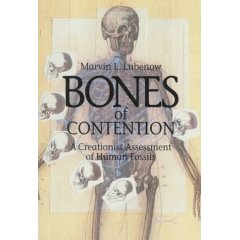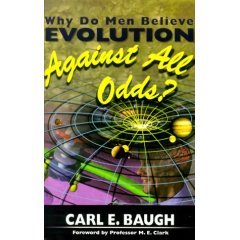Bones of Contention: A Creationist Assessment of Human Fossils
 Author: Marvin L. Lubenow
Author: Marvin L. LubenowPublication: Baker Books 1992
This book, as the subtitle indicates, concerns itself only with the human fossil record (as opposed to other fossils). Toward this end, the author employs vast amounts of research to demonstrate that the hominid fossil record does not support the concept of evolution. At the very least, he demonstrates that the extant hominid fossil data could just as easily support creation as it could evolution. If the reader finds the majority of Lubenow's arguments convincing, however, it seems as if the hominid fossil record certainly favors Biblical Special Creation.
Lubenow begins his book by taking the reader on a brief behind the scenes look into paleoanthropology. His primary concern is dispelling certain myths that the public has about such things. His first chapter deals with the fact that the majority of paleoanthropologists never actually study a single genuine hominid fossil. They may have papers, casts, or illustrations, but the originals are locked far away. He intends to point out that in this field of study, the data upon which these scientists make conclusions isn't even truly available to them. His second chapter briefly touches on how subjective and speculative paleoanthropology and evolution can be using examples and quotes from respected figures. His third chapter takes the commonly held assertion that the hominid fossil record is scant, or lacking, and juxtaposes it with the fact that at least 4,000 hominid fossils had been discovered in the late 1970's and that by the 90's that number climbed to around 6,000. He explains that a small or lacking fossil record is only true of those fossils which supposedly support evolutionary theory, the remaining thousands are not included in those figures. Chapter four introduces some well known evolutionary hoaxes and chapter five gives some very enlightening examples of how fossils found out of place in the evolutionary time scale are quite conveniently reclassified, re-dated, or otherwise altered to distort the truth. Up until now, he has only given brief accounts.
Chapters six through sixteen are the meat of this book. It is here that Lubenow gives a detailed account of the hominid fossil record and illustrates his main points. Namely that hominid fossils do not match the evolution time scale and thus can not be used to support it. It is also here that Lubenow publishes his powerful evidence in the form of fossil charts. He has taken the hominid fossil record as a whole and created relevant charts that outline the timeline of the various fossils. These charts form the crux of his argument.
Chapter 6 discusses Homo neanderthalensis. Lubenow shows that the entire neanderthal record is contemporaneous both with fossils more modern and more archaic. How can this taxon be considered transitional if no such transition has taken place among the fossils? To be fair, not all evolutionists consider H. neanderthalensis to be in the H. sapiens ancestry, but many do.
Chapter 7 discusses archaic H. sapiens. Again, the chart shows that archaic H. sapiens coexisted with H. sapiens, H. neanderthalensis, and H. erectus. No evolutionary transition can be legitimately drawn from this data.
Chapters 8 through 14 all focus on H. erectus. It is not my intention to provide a complete outline of this material, only some highlights. He spends a fair amount of time illustrating questionable practices among evolutionists, such as Eugene Dubois. He also points out that fossils much more recent in morphology coexist with H. erectus. His most forceful argument comes in his three page spread of H. erectus existing, at the very least, from 2 million years ago up until 6,000 years ago (by the evolution time scale, that is). This puts the H. erectus taxon way out of bounds, way out of a proper transitional period, and way out of range to base evolutionary theory upon.
Chapter 15 touches on H. habilis, which he considers to be a flawed taxon composed of some small Australopithecine like apes and some larger Homo fossils. He has already shown that H. habilis existed alongside H. erectus for its entire recorded history (which again rules out any conclusive transition).
Chapter 16 sums up his fossil arguments and gives the most comprehensive fossil charts. To sum it up, he demonstrates that throughout the entire hominid fossil record, the Homo fossils (especially sapiens and erectus) have existed from beginning to end. There are no clear cut transitions, there are no appropriate boundaries from one taxon to another, and there are no examples of one taxon evolving into another. To put it lightly, he leaves the reader with enough evidence to sleep comfortably knowing that human evolution is in no better position than special creation.
Perhaps the most important thing to gain from this book is the knowledge that evolution is based entirely on speculation. There is absolutely no way to conclusively prove that one fossil, or group of fossils, evolved into another. Those relationships can only be speculated. With this foundation, the reader can look at the data for him/herself and see that the hominid fossil record does not demonstrate evolution at all. Instead, the record shows modern H. sapiens existing from the beginning of the record and the other taxa existing right alongside him.
Lubenow believes that all the fossils are either humans (H. sapiens) or are some form of extinct ape. He explains that pathological conditions, such as rickets, scurvy, congenital syphillis, etc..., can very easily create the sort of features that evolutionists claim are indicative of primitive ape-men. If variations among modern humans, for reasons either pathological or genetic, can account for the vast variation among the fossil record (which Lubenow takes pains to show is quite possible), evolution is not necessary to explain anything. On the contrary, creation becomes a more plausible scenario. In fact, Lubenow postulates that the world-wide Genesis flood perfectly explains why a world-wide ice age took place which necessarily caused exactly the pathological conditions that we find among the ancient human fossils. Biblical creationism harmonizes perfectly with the fossil record when viewed this way.
The remaining chapters are not so much about human evolution as they are about theology. He touches on the Big Bang Theory and provides a detailed appendix on the dating of fossil hominid KNM ER 1470, but the rest is more concerned with Biblical interpretation and a creationist world view.
Overall, Lubenow's book is both ground-breaking and foundational. He puts forth such solid evidence for his position that he forces critics to engage him on fair ground. Without a doubt, he demonstrates that evolution has not proven anything conclusively about human origins, and that the evidence rather favors a different explanation. His charts build a platform of information readily accessible to any reader and demonstrate anything except supposed human evolution. Take a look for yourself, the fossils do not favor evolution.
Evolution, to be sure, can be speculated from the fossil record but only if the most important fossils are yet to be found. Creation, however, can also be speculated, and is in the comfortable position of more harmonious evidence. After this book, you will never think about fossils the same way. Lubenow has done the world a favor. Of course, I have only lightly touched on the points of this volume. To really understand Lubenow's position and evidence, you must (and should!) read this book for yourself, you won't be sorry.





